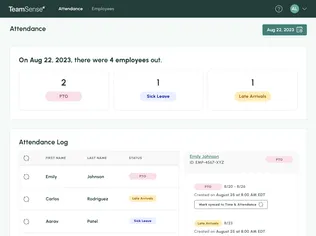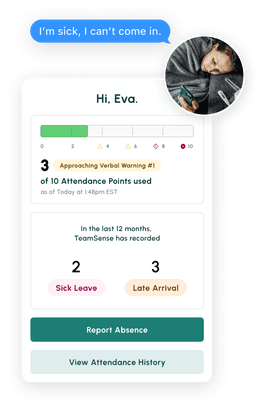When to HR with AI (and When Not To)!
Table of Contents
- Why are your employees leaving?
- The Great Resignation Trend
- What is Employee Retention?
- Why is Employee Retention Important?
- Effective Employee Retention Ideas - 15 Tips
- 1. Create career growth tracks.
- 2. Show appreciation often.
- 3. Create employee groups to connect.
- 4. Cultivate a culture of employee recognition.
- 5. Invest in your managers.
- 6. Take a look at your benefits package.
- 7. Make sure your pay is competitive.
- 8. Offer more flexibility.
- 9. Get intentional about company culture.
- 10. Support well-being by eliminating burnout.
- 11. Have a solid onboarding process.
- 12. Connect the impact of your employee’s role to the impact of the company.
- 13. Focus on employee engagement.
- 14. Focus on team building.
- 15. Get more feedback.
Employee retention is one of the most important aspects of any successful business. It is imperative to deploy and execute a number of effective employee retention strategies to motivate employees and keep them onboard.
Happy employees lead to productive teams, which leads to better work and higher profits. While unhappy employees often exit or quite quit, either way, the results of employee dissatisfaction are costly and disruptive! It's often difficult to find someone who is a good fit for your company culture and who has the skills you need - so when you do, keeping them is a must!
In this blog post, we will discuss 15 strategies that you can use to improve and increase employee engagement and retention in your business. We will also talk about the importance of increased employee engagement and retention and how it can benefit your company in many ways. If you are looking for ways to keep your employees happy and motivated, then this blog post is for you!
Why are your employees leaving?
This is the first thing you need to ask yourself when you are trying to improve employee retention. If you don't know why your employees are leaving, then you can't fix the problem! There could be many reasons why employees decide they are leaving, such as:
- - They aren't being paid enough
- - They don't feel challenged in their role
- - They don't get along with their supervisor/colleagues
- - They don't feel appreciated or valued
- - They are not given the right tools and resources to do their job properly
Once you know why your employees are leaving, then you can start looking at ways to improve the situation. One way to do this is to conduct exit interviews with those who have left to gain a better understanding of the departing employee's experience and their reasons for leaving. Don't forget to talk to your existing employees and discuss how they are feeling about company morale.
The Great Resignation Trend
Has The Great Resignation got your company down? You’re not alone. The Great Resignation has done a number on employee morale and retention rates these last few years, and plenty of companies have struggled to retain their team members. This has led to the job market offering competitive pay while providing top talent with exciting benefits.
You can then take the feedback and form an employee retention strategy. This could involve implementing changes such as providing valuable employees with better pay and benefits, increasing training opportunities, creating a more positive work environment, or even introducing perks such as free snacks or team socials.
After all, it wasn’t that long ago that a new record was set on the labor turnover front. In March 2022, a record number of 4.5 million people quit their jobs in the U.S.1
And if you feel like you’re fighting the uphill battle against retention rates and just can’t seem to win, we’ve got some good news for you. Here are 15 of the best employee retention strategies to keep your team from jumping ship. But before we dive in, let’s talk about employee retention and why it matters so much.
Save Hundreds of Hours A Year With TeamSense

See how TeamSense saved HelloFresh 3-4 hours per day managing attendance through text. Read the case study and book your demo today!
What is Employee Retention?
Simply put, employee retention is just the process of keeping your team at your company and reducing employee turnover (employees exiting your company). Employee retention strategies take time and intention.
Why is Employee Retention Important?
Employee retention matters overall to your business's health, success, and quality. But that doesn’t mean it’s an easy feat. Making employee retention a priority takes time and intention. It can be tricky, but it's worthwhile to undertake at your company if you want a solid team.
Talented, quality employees can be hard to find. And your company’s goal should be figuring out how to get that talent in the door and keep them there. Not to mention, training costs and replacing an employee isn’t cheap. The hiring process of finding a replacement for a former team member can cost 16% to 213% of an employee's salary.2 Needless to say, you really want to retain employees and encourage professional development, employee satisfaction and give your employees reason to stay.

Effective Employee Retention Ideas - 15 Tips
Here are 15 strategies that you can use to keep your employees happy and motivated!
1. Create career growth tracks.
If you want employees to stick around, it’s important to create intentional paths to growth at your organization. Employees need to see that they can grow at your company, and the journey of getting there isn't a big secret. Prioritize clear communication about the next steps for growth in your organization and create straightforward ways to get there for new hires as well as remaining employees.
2. Show appreciation often.
It goes without saying that when employees feel valued, they will be more likely to stick around. So be sure you make your appreciation known to your team. There are plenty of ways to appreciate your employees—a simple thank you card, a shout-out in a meeting, or even a pay bump can go a long way.
3. Create employee groups to connect.
Everyone wants to find their place within a company, but sometimes that’s easier said than done. Your company can help facilitate a sense of belonging by offering employee groups to connect based on interest or demographic. This helps facilitate further work life balance and a workplace culture tenured employees won't want to leave.
4. Cultivate a culture of employee recognition.
Here’s something you should always keep in mind—employee recognition isn’t just the supervisor’s job. It falls on fellow team members too. Make an effort to weave employee recognition into the culture of your company. This means it should be common to hear co-workers praise one another and show gratitude for their colleagues' contributions.
Some great tools out there, like Bonusly, let people across the company show their appreciation by awarding points to other co-workers. Those points can be saved up and cashed out for gift cards. Consider a system like this that rewards employees for a job well done while encouraging others to recognize excellence.
5. Invest in your managers.
Continued education is essential to employee growth, but sometimes companies forget that managers need that too. Help your managers and supervisors succeed by setting up courses for those new in management and those looking to polish their skills. Remember, investing in your team matters—no matter if your employees are entry-level or in senior management positions.
6. Take a look at your benefits package.
Employee benefits are a big deal. Things like health insurance, PTO policies, and retirement offerings all impact the overall benefits package. Benefits impact not only employees but their dependents/families as well. Because an employee benefits package can have a far-reaching effect, many employees will take a new job based on better benefits.
If you want to retain employees, be sure you're offering benefits as good as others within your industry.
7. Make sure your pay is competitive.
Here’s the hard truth: 63% of employees leave a job because of inadequate salary.3 Now, that doesn't mean you should automatically increase everyone's income. But it does mean you should start looking at your compensation package and see if it's competitive for your industry. If you see that your salaries are on par with industry standards from 15 years ago, that could explain why you’re having a hard time retaining employees.

8. Offer more flexibility.
We know when you hear the word "flexibility," these days, everyone thinks of remote work and hybrid, flexible schedules. But the truth is that flexibility isn't just for working from home and remote employees. When it all comes down to it, flexibility is all about prioritizing a healthy work life balance for your team. And if your company lives out that kind of core value, it will, without a doubt, be one of the most valuable employee retention strategies you use.
Offering a more flexible work schedule can also improve your absenteeism rates.
9. Get intentional about company culture.
"Company culture" has become a buzzword in HR, but that's for a good reason. Defining what is different and unique about your company will help to keep employees engaged with your mission, goals, and team dynamic.
Think about what makes your company unique. What makes you stick out when compared to your competitors in the industry? What does your current team say about your culture right now? Just knowing these things and officially defining them as your company culture can go a long way toward increasing employee retention. Employees seek out companies with a culture they want to be a part of. And healthy company culture is contagious.
10. Support well-being by eliminating burnout.
Employee burnout and fatigue are real issues impacting employee retention. In fact, a survey by Indeed found that 52% of employees admit they feel burned out.4 And if your company isn't doing anything to combat employee burnout, you can expect to see that reflected in your retention rates.
If you want to become an advocate for reducing employee burnout, start encouraging sick employees to call out and use sick time (that’s what it’s there for, after all). It’s important that your team realizes you want them to put their health and well-being first.
11. Have a solid onboarding process.
Onboarding might just be a one-off experience for a new hire at your company, but it sure does matter. In fact, organizations with a strong onboarding process improve new hire retention by 82% and productivity by over 70%.5 So if you really want to improve your employee retention rates, pay attention to how you onboard your team members.
12. Connect the impact of your employee’s role to the impact of the company.
Employees want to know that their job is making an impact across the organization. And employees who feel more connected to the company will be able to see their career there long term. So be sure to communicate how impactful their work is to the growth and success of the company.
13. Focus on employee engagement.
Employee engagement matters. An engaged employee is more likely to stick around at your company for a while. In fact, 88% of highly engaged employees say they will still be at their company in a year, compared to 49% of disengaged employees.6
14. Focus on team building.
A great way to help employees feel more engaged is by helping them connect with their team. After all, feeling a sense of belonging with your co-workers can go a long way to help boost employee retention. So focus your efforts on helping to facilitate team building whenever you can. You can’t build trust in a day, but you can take steps each day to help cultivate it.
15. Get more feedback.
Learning ways to improve your company is valuable—but hearing it firsthand from your employees is extremely valuable. Many employees want to share their suggestions on how to improve the company or how satisfied they feel with their work. But they have to be asked and know that they can share their thoughts without fear of retaliation.
Pulse surveys are a great solution for collecting employee feedback in a non-threatening way. And the great news is it's easy to get participation if you have the right tools.

Is your call-in process terrible? Text reduces no-shows and absenteeism by up to 40%.
Don't believe us? Check out this case study to see how this 3PL benefited.
Keep the Feedback Loop Going With TeamSense As a part of your employee retention strategy
It's no secret that getting team members to complete feedback surveys is difficult. And it’s even more tricky if you have a team of hourly workers on a factory line. That’s why TeamSense makes it easy to reach your team—wherever they are. With pulse feedback surveys sent over text, it’s much easier to get your employees to actually respond. After all, 99% of all text messages end up being looked at—with 90% of them read in the first three minutes.7
So try a few of these new employee retention tips, make it a point to listen to what the top talent on your team is saying, and see if those retention numbers start turning around.
Frequently Asked Questions
-
Employee retention involves keeping your current employees happy and motivated, while employee turnover is when employees quit, or they leave the company. In short, you don't want turnover; you want to retain your existing satisfied employees.
-
Your employee turnover rate is calculated by dividing the number of employees who left during a given period by the average number of employees over that same period. For example, if you had 10 employees leave in a quarter, and an average of 100 employees each month over that quarter, then your turnover rate would be 10%.
-
The best way to measure the success of your employee retention strategies is by tracking your turnover rate. If it goes down, then you know that your retention efforts are making a difference in employee loyalty and employee job satisfaction. You can also use surveys and feedback from employees to gauge their satisfaction with their job and overall morale in the company.
-
A good employee retention rate varies from industry to industry. Generally, a rate of 70-80% is considered average, while anything over 90% is considered excellent. It's important to note that your employee experience and turnover rate should be constantly monitored and compared with the industry standard for your sector in order to ensure you are making progress.
-
The key to creating a successful employee retention strategy is having a clear understanding of why your employees are leaving in the first place. Once you know this, you can use the feedback from exit interviews and employee surveys to create an effective plan that addresses these issues. Additionally, it's important to stay up-to-date on industry trends and best practices to ensure that you are keeping up with the competition. Finally, implementing rewards and recognition into your effective retention strategy can help create a positive work environment and create a culture that motivates employees to stay.
About the Author

Sheila Stafford, CEO of TeamSense & AI in HR Innovator
As CEO of TeamSense, Sheila Stafford is at the forefront of transforming HR for frontline teams through AI-driven solutions. With a commitment to enhancing employee relations and simplifying workforce management, Sheila leads TeamSense in pioneering advancements that empower both frontline employees and HR teams. Her visionary approach combines cutting-edge technology with a thoughtful focus on enhancing human connection; Sheila strategically implements AI where it adds the most value while recognizing the critical role of personal interaction and ensuring that human engagement remains central when it matters most. Under her leadership, TeamSense is redefining how companies support and engage their frontline teams for a more connected, efficient workplace.



![20+ Statistics About Absenteeism in the Workplace [2025]](https://optimise2.assets-servd.host/glib-coyote/production/images/absence-trends.png?w=345&h=210&q=80&fm=webp&fit=clip&dm=1691666357&s=8b32c8f60759e61c3f8c95882217631c)

